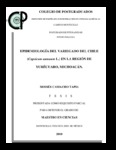Epidemiología del variegado del chile (Capsicum annuum L) en la región de Yurécuaro, Michoacán
Abstract
En los municipios de Yurécuaro y Vista Hermosa, con el objetivo de determinar el comportamiento de la epidemia del variegado del chile asociada a Candidatus Liberibacter solanacearum, se realizó un análisis espacio-temporal de dicha epidemia. Para confirmar la presencia de la bacteria, se colectaron muestras de chile con síntomas de clorosis, deformación de hojas, variegado y albinismo, además semillas de frutos de plantas en etapa de corte, también se colectó el insecto vector Bactericera cockerelli Sulc. Se realizó muestreo regional de diez parcelas de cultivo de chile en la etapa final para comparar la distribución espacial. Se realizaron mapas bidimensionales y tridimensionales, además se estimaron los índices de agregación usando los métodos de Morisita y Lloyd, y se obtuvo el tamaño óptimo de cuadrante por el método de Greig-Smith modificado Campbell y Madden. Para el análisis temporal, se realizó un ajuste por R2 con los modelos epidemiológicos para tener un indicador del proceso biológico del desarrollo de la epidemia. El índice de agregación obtenido fue uniforme considerándose un tamaño óptimo del cuadrante de 64, la epidemia se ajusto al modelo logístico. _______________ EPIDEMIOLOGY OF VARIEGATED PEPPER (Capsicum annuum L.) IN THE REGION OF YURÉCUARO, MICHOCÁN. ABSTRACT: In the Municipalities of Yurécuaro and Vista Hermosa, Michoacán, the research was conducted with the objective to determine the behavior of the epidemic of the variegated pepper associated with Candidatus Liberibacter solanacearum. A spatial- temporal analysis was conducted of the epidemic, to confirm the presence of the bacteria samples of pepper with symptoms of chlorosis, leaf deformation, variegation and albinism and seeds of fruits of plants in the harvesting stage was analyses, also was collected the insect vector Bactericera cockerelli Sulc, A regional sample of ten plots of pepper in the final stage was conducted to compare the spatial distribution. Bidimensional and tridimensional maps were made and the indexes of aggregation were estimated by the methods of Morisita and Lloyd and the optimum size of the quadrant were obtained using the method of Greig-Smith modified by Campbell and Madden. The temporal analysis of the epidemiological models was adjusted with R2 to find an indicator of the biological process of the development of the epidemic. The aggregation index was uniform considering an optimal quadrant of 64. The epidemic was adjusted to a logistic model.
Collections
- Tesis MC, MT, MP y DC [221]

